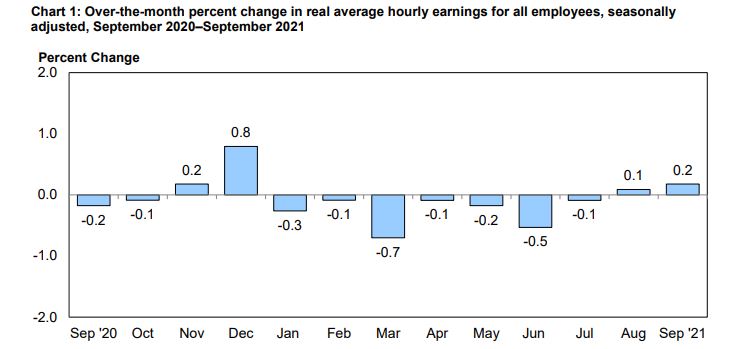Employment Blog October 2021
This report is from the U S Department of Labor, Bureau of Labor Statistics. Nonfarm payroll employment rose by 194,000 in September, and the unemployment rate fell by 0.4 percentage point to 4.8 percent. Notable job gains occurred in leisure and hospitality, in professional and business services, in retail trade, and in transportation and warehousing. Employment declined in public education over the month. Thus far this year, monthly job growth has averaged 561,000. Employment has increased by 17.4 million since April 2020 but is down by 5.0 million, or 3.3 percent, from its level before the onset of the coronavirus (COVID-19) pandemic in February 2020.


Employment in leisure and hospitality rose by 74,000 in September, after changing little in August. Arts, entertainment, and recreation added 43,000 jobs in September. Employment in food services and drinking places changed little for the second consecutive month, following an average monthly gain of 197,000 from January through July. Employment in leisure and hospitality is 1.6 million, or 9.4 percent, lower than in February 2020.
In September, employment in professional and business services rose by 60,000. Within the industry, employment in the professional and technical component rose by 56,000 over the month and is 244,000 higher than in February 2020. (Professional and technical services includes industries such as architectural and engineering services, management and technical consulting services, and computer systems design and related services.) By contrast, employment in the administrative and waste services component (which includes temporary help services) changed little over the month (+2,000) but is 543,000 lower than in February 2020. Employment in the management of companies and enterprises component was also little changed over the month (+3,000) but is down by 86,000 since February 2020. Employment in professional and business services overall is down by 385,000 since February 2020.
Employment in retail trade rose by 56,000 over the month, after changing little in the prior 2 months. In September, job gains occurred in clothing and accessories stores (+27,000), general merchandise stores (+16,000), and building material and garden supply stores (+16,000), while food and beverage stores continued to lose jobs (-12,000). Since February 2020, employment in retail trade is down by 202,000.
Transportation and warehousing added 47,000 jobs in September. Employment in the industry is 72,000 above its February 2020 level. In September, employment growth continued in warehousing and storage (+16,000), couriers and messengers (+13,000), and air transportation (+10,000).
Employment in information rose by 32,000 in September, with job gains in motion picture and sound recording (+14,000); in publishing industries, except Internet (+11,000); and in data processing, hosting, and related services (+6,000). Employment in information is 108,000 lower than in February 2020.
In September, employment in social assistance increased by 30,000, with much of the gain occurring in child day care services (+18,000). Since February 2020, employment in social assistance is down by 204,000.
Manufacturing added 26,000 jobs in September, with gains in fabricated metal products (+8,000), machinery (+6,000), and printing and related support activities (+4,000). Motor vehicles and parts lost 6,000 jobs over the month. Since February 2020, employment in manufacturing is down by 353,000.
In September, construction added 22,000 jobs. Employment in the industry has changed little, on net, thus far this year and is 201,000 lower than in February 2020.
Employment in wholesale trade increased by 17,000 in September, with nearly all of the gain in the durable goods 4 component. Wholesale trade employment is 159,000 lower than in February 2020.
Mining employment continued to trend up in September (+5,000), reflecting growth in support activities for mining (+4,000). Mining has added 59,000 jobs since a trough in August 2020, but employment is 93,000 lower than a peak in January 2019.
In September, employment decreased by 144,000 in local government education and by 17,000 in state government education. Employment changed little in private education (-19,000). Most back-to-school hiring typically occurs in September. Hiring this September was lower than usual, resulting in a decline after seasonal adjustment. Recent employment changes are challenging to interpret, as pandemic-related staffing fluctuations in public and private education have distorted the normal seasonal hiring and layoff patterns. Since February 2020, employment is down by 310,000 in local government education, by 194,000 in state government education, and by 172,000 in private education.
In September, employment changed little in health care (-18,000). A job gain in ambulatory health care services (+28,000) was more than offset by job losses in nursing and residential care facilities (-38,000) and hospitals (-8,000). Health care employment is 524,000 lower than in February 2020, mostly due to declines in nursing and residential care facilities.
Employment in financial activities and in other services showed little change over the monthed to 4.8 percent.
Real average hourly earnings for all employees increased 0.2 percent from August to September, seasonally adjusted, the U.S. Bureau of Labor Statistics reported today. This result stems from an increase of 0.6 percent in average hourly earnings combined with an increase of 0.4 percent in the Consumer Price Index for All Urban Consumers (CPI-U). Real average weekly earnings increased 0.8 percent over the month due to the change in real average hourly earnings combined with an increase of 0.6 percent in the average workweek.

